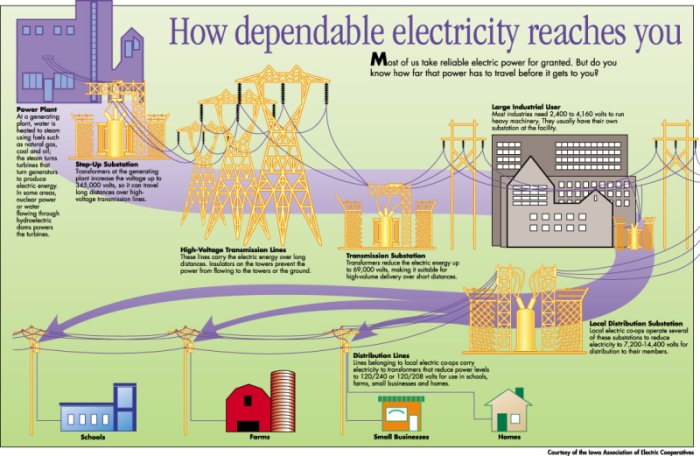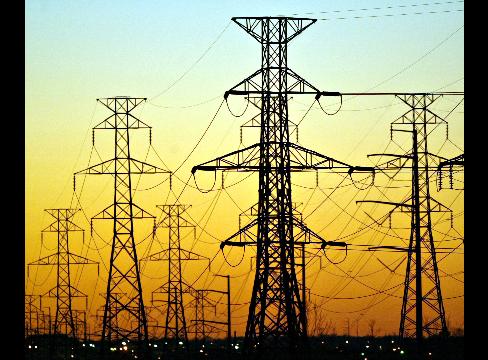|
By Walter Sorochan, Emeritus Professor: San Diego State University Posted December 01, 2010; updated November 13, 2021.
Today’s out-dated power lines are holding us back from saving electricity: The current Power Grid is making the transmission of electricity worse.
Getting energy control in California: Many cities and communities have been busy developing and implementing electrical supply systems that do away with our dependence on nuclear power and coal plants. For example, San Francisco and Marin county have legislated to implement solar power. From the North Bay to Hollywood, California communities are trying to exert more control over the future of their electrical power. The existing power grid in California is so unreliable that tech giant Oracle, in Silicon Valley, California, is underwriting the construction of its own balkanized energy network in the form of substations, diesel generators, and power-conditioning systems. Another company, SolarCity, completed installation of the largest commercial solar power plant in eBay's North campus in San Jose, California. SolarCity estimates that over the next three decades, eBay's solar system will offset 37 million pounds of carbon dioxide; the equivalent of planting 322 acres of trees. SolarCity also estimates that solar-generated power will save eBay approximately $100,000 in electricity costs within its first year of operation. Both Oracle and Ebay computing-internet facilities need continuous, uninterrupted and reliable power and cannot rely on their local power grids. The trend here sends a clear message that the existing power grids can no longer supply reliable electricity to customers. This is a “ wake-up “ call! The Grid Problem: The continental United States is divided into three main 
A major problem with electricity and power lines is that electricity cannot be stored at the present time. Electricity today needs to be continuously generated and pumped it into the grid system. New Grid Technology: Awareness of the ineptitude of the current grid  system has opened the door to find a variety of new and related technologies to fix the inadequate power grid. The trend is away from today’s centralized grid and toward Distributed Energy Systems that are small-scale power generation technologies. Decentralized power grids that are near the power source and also consumers would lower the cost of transporting electricity from the power plant to the consumer by between 50 to 70 %. This would be a huge saving for consumers. Such savings would also make solar energy more competitive with nuclear and fossil fuel power plants. Smart Grid Solar System: Imagine a small community of 1000 or 5000 home owners forming a partnership or association to use solar panel technology to provide and store electricity to themselves; but at the same time selling excess electricity to the local power grid. Another approach is to set up neighborhoods that run entirely on direct current (DC) or DC Microgrids. For example, a California utility, Pacific Gas and Electric, is one of several entities that has been pressured into developing an electricity grid of the future, one that will look more like an internet - distributed, interactive, open-source system. Other companies are implementing ways to use computer technology and software to monitor consumer use of electrical energy as well as interfacing and bringing small providers on board. A Boulder, Colorado based company, GridAgents, has developed a software system that allows utilities to better manage different kinds of distributed power generation from solar panels. There is investment interest in renewing transmission grids. For example, the Hunt family of Dallas, through its Sharyland Utilities affiliate, is building an 800-mile electric transmission loop in the Texas Panhandle. Current electric companies in California, Pacific Gas and Electric and SDGE, are providers of electricity to consumers. These companies need economic incentives to change. Legislation Needed: We need to consider passing additional state legislation that encourages development of solar electricity. For example:
Conclusion: The existing power grids are no longer able to provide uninterrupted and reliable electric power. We need a new coordinating grid capable of networking millions of distributed energy devices such as solar panels, wind turbines, electric vehicles, and smart appliances. We need a Smart Grid that uses the internet technology to monitor and control consumers and suppliers on the grid system. We desperately need to install distributed grid systems that are not under the control of corporate grids. References: Mills Mark P., "The Future Electric Grid," American.com., May 31, 2014. Article by Mills: Future Electric grid is no longer active. Savitz Eric, "Living In The Dark: Why The U.S. Needs To Upgrade The Grid," Forbes, JUL 11, 2012. Savitz: Upgrading Grid 2012 |
 Providing more electricity does not solve our need for more electricity as the
stumbling block is the delivery system itself! Grid companies do not have
economic incentives to upgrade. We should be investing in the future new smart
and decentralized power grid. The new system would build power plants nearby
consumers, thereby minimizing the distance electricity travels.
Providing more electricity does not solve our need for more electricity as the
stumbling block is the delivery system itself! Grid companies do not have
economic incentives to upgrade. We should be investing in the future new smart
and decentralized power grid. The new system would build power plants nearby
consumers, thereby minimizing the distance electricity travels.